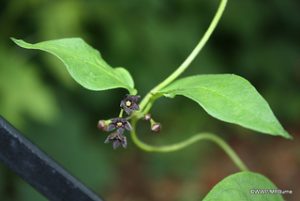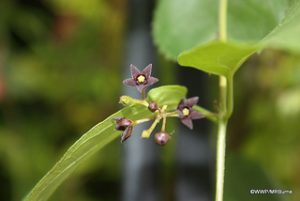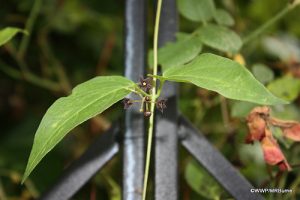Black Swallowwort
(Cynanchum louiseae syn: Cynanchum nigrum)
Family: Milkweed family (Asclepiadaceae)
Native Range: Europe (Italy, France, Portugal, and Spain)

Ecological Threat
Black swallow-wort can form extensive patches that crowd out the native vegetation. Old field habitats of goldenrod and grasses can be replaced almost exclusively by swallow-wort. The globally rare alvar ecosystems (limestone pavement barrens supporting unique plant communities), are threatened by many rapidly expanding swallow-wort populations in Jefferson County, New York. Black Swallow-wort threatens to displace Jessup’s milk vetch, a federally listed plant, on the banks of the Connecticut River valley in central Vermont. Investigations into impacts on the monarch butterfly, which requires milkweeds for reproduction, indicate that the butterfly will cue into black swallow-wort and lay eggs, but the larvae do not survive.
Distribution and Background
The first collection of black swallow-wort in North America was from Ipswich, Essex County, Massachusetts, in 1854. An 1864 Essex County collector recorded that it was “escaping from the botanic garden where it is a weed and promising to become naturalized.” The fifth edition of Gray’s Manual of Botany (1869) reports black swallow-wort to be a weed escaping from gardens in the Cambridge Massachusetts area.
Black swallow-wort is a problem plant in many parts of the country and now is present in every New England state.
Black swallow-wort is associated exclusively with upland areas and is tolerant of a range of light and moisture conditions. The species can be found above the high tide line of some rocky coastal areas where it can tolerate relatively high salt concentrations. Typical habitats include old fields, hedgerows, brushy areas, and the ground layer of woodlands. Areas of both natural and human-caused disturbances, including ice-scoured river banks, talus slopes, transportation corridors, quarries and abandoned agricultural fields, provide susceptible habitats. Black swallow-wort has also been reported to be an intractable weed in gardens of New England. It can occur on both basic and acidic soils.
Biology and Spread
 Black swallow-wort emerges in spring and flowers from June to July. The flowers are self-pollinating. Fruits are soon produced, turning from green to light brown as they mature. The number of pods is directly related to the level of light available. When ripe, the fruits open along a seam and release flattened seeds equipped with downy parachutes that aid in wind dispersal. Black swallow-wort spreads long distances by seed. Local spread and establishment is frequently through clonal growth from rhizomes. Thick infestations in full sun can produce 2,000 seeds per square meter. The seeds have one to four embryos per seed which greatly increases the likelihood of seed survival and establishment. Wind dispersal of seed begins in late July to early August and continues throughout late summer and fall. Populations growing under dense wooded canopy may not produce flowers or seeds. Black swallow-wort dies back to the ground every winter.
Black swallow-wort emerges in spring and flowers from June to July. The flowers are self-pollinating. Fruits are soon produced, turning from green to light brown as they mature. The number of pods is directly related to the level of light available. When ripe, the fruits open along a seam and release flattened seeds equipped with downy parachutes that aid in wind dispersal. Black swallow-wort spreads long distances by seed. Local spread and establishment is frequently through clonal growth from rhizomes. Thick infestations in full sun can produce 2,000 seeds per square meter. The seeds have one to four embryos per seed which greatly increases the likelihood of seed survival and establishment. Wind dispersal of seed begins in late July to early August and continues throughout late summer and fall. Populations growing under dense wooded canopy may not produce flowers or seeds. Black swallow-wort dies back to the ground every winter.
Alternative Plants (Alternative Native Species)
In the eastern U.S., the native honeyvine (Cynanchum laeve) can be substituted for the invasive black swallow-wort. Other attractive native vines that are widely available in the East include:
- Trumpet honeysuckle (Lonicera sempervirens)
- Virginia creeper (Parthenocissus quinquefolia)
Whenever possible, use as alternatives plant species that are native and adapted to the ecological region where you live. They will be more valuable to the wildlife species that have evolved with them and depend upon them for food and shelter. Check with your local native plant society for recommendations and sources of native plants.
Management Options
 As with all invasive species, early detection and removal is the best approach for preventing the establishment and spread of this plant. If you find some black swallow-wort, look for more, and aim to remove all plants at a site. Stay out of patches that are actively dispersing seeds unless you plan to collect and dispose of the seeds carefully. Clean all machinery that has traveled through swallow-wort patches that have maturing or dispersing pods.
As with all invasive species, early detection and removal is the best approach for preventing the establishment and spread of this plant. If you find some black swallow-wort, look for more, and aim to remove all plants at a site. Stay out of patches that are actively dispersing seeds unless you plan to collect and dispose of the seeds carefully. Clean all machinery that has traveled through swallow-wort patches that have maturing or dispersing pods.
Chemical control is the most effective means for large established infestations.
For disposal options, refer to the control and disposal page.
Plant Control
Manual, mechanical and chemical control methods are effective in removing and killing Black swallow-wort. A combination of methods often yields the best results and may reduce potential impacts to native plants, animals and people. The method selected depends on the extent and type of infestation, the amount of native vegetation on the site, and the time, labor and available resources.
Biological
There are no biological controls available for this plant.
Manual
Remove pod-bearing plants from the site and destroy them. Eradication on a small scale must be very thorough and requires dedication. The complete root crown must be dug out before the seeds ripen.
Collect and bag plants bearing seeds and dispose of them in heavy garbage bags. Infested land might be brought under control by plowing and planting an annual crop until the seed soil bank is depleted, possibly as long as five years.
Mechanical
Mowing, even several times a year, will not eradicate Black swallow-wort but is useful for preventing a seed crop. Cutting early in the season to mid-July when there are small, immature pods on the plants is effective at preventing a mature seed crop. Cutting during the flowering period but before pod formation will allow plants to recover and still produce a viable seed crop. Monitor mowed areas and mow a second time if pods reach mature size in late summer or early fall. Hay cutters can contribute to the spread of swallow-wort if cutting is not timed correctly. Hay crops infested with Black swallow-wort and then sold elsewhere can introduce Black swallow-wort to new areas.
Chemical
Two systemic herbicides are effective in controlling pale swallow-wort – Garlon® 4 (triclopyr ester) and Roundup Pro® (glyphosate). Apply these herbicides when plants are actively growing, after flowering has begun.
DO NOT SPRAY TOO SOON. Avoid the temptation to spray the plants as soon as they emerge in May. Only when the plants flower will they be large enough to receive enough spray on the exposed leaf surface to deliver a killing dose to the roots. Plants that are sprayed before pods form may not produce a viable seed crop that season. Be patient. Systemic herbicides do not cause a “burn down” of plants like contact herbicides do, but within 1-2 weeks the plants will be visibly weakened. There may be dead tissue spots on most leaves as well as many yellowing leaves. Do not waste herbicide, money or effort by spraying plants twice. Sick plants cannot effectively absorb the herbicide through the leaf surface or move the herbicide to the roots. Swallow-wort is a tough customer, and can take years to eliminate.
Caution: Applying herbicides to control invasive plants on property you do not personally own requires a pesticide applicator’s license issued by the state. A pesticide applicator’s license is required to use herbicides on public and private conservation lands.
Caution: Any activities in wetlands (from removing invasives by hand or by applying herbicides) may require a special permit under the Wetlands Protection Act and/or your local bylaws. Be sure to contact your local Conservation Commission before you act.
Notice: Mention Of Pesticide Products On This Web Site Does Not Constitute Endorsement Of Any Material.
More Information
For more information on invasive species in Massachusetts, refer to the Massachusetts Prohibited Plant List at https://www.mass.gov/massachusetts-prohibited-plant-list.
Author
Jill M. Swearingen, National Park Service, Washington, DC
References
Cappuccino, N., MacKay, R. and Eisner, C. 2002. Spread of the invasive alien Vincetoxicum rossicum: tradeoffs between seed dispersability and seed quality. Am. Mid. Nat. 148: 263-270.
Casagrande R. A. and Dacy, J. 2001. Monarch Butterfly (Danaus plexippus) oviposition on Black Swallowort (Vincetoxicum nigrum). Rhode Island Nat. Hist. Surv. 8: 2-3.
Christensen, T. 1998. Swallow-worts, the ecology and control of Vincetoxicum spp. Wildflower: 21-25.
DiTommaso A. and Losey, J. E. 2003. Oviposition selection and larval feeding by Monarch Butterflies on two invasive swallow-wort species. Proceeding of the Annual Meeting of the Northeastern Weed Science Society of America 57:121.
Ernst, C. and Cappuccino, N. 2003 The effects of an invasive vine, Vincetoxicum rossicum, (Asclepiadaceae) on old-field arthropod assemblages in Ottawa, Ontario. (Talk) New England Invasive Plant Summit, September 19-20, 2003, Framingham, Massachusetts
Greipsson, S. and DiTommaso, A. 2002. Impact of the invasive plant Vincetoxicum rossicum on activity of arbuscular mycorrhizal fungal populations. Ecological Society of America Meeting Abstracts 87: 358.
Haribal, M. and Renwick, J.A.A. 1998. Identification and distribution of oviposition stimulants for Monarch butterflies in hosts and non-hosts. J. Chem Ecol. 24: 891-904.
Kartesz, J.T. 1999. A Synonymized Checklist and Atlas with Biological Attributes for the Vascular Flora of the United States, Canada, and Greenland. First Edition. In: Kartesz, J.T., and C.A. Meacham. Synthesis of the North American Flora, version 1.0. North Carolina Botanical Garden, Chapel Hill, NC.
Lawlor, F. M. 2000. Herbicidal treatment of the invasive plant Cynanchum rossicum and experimental post control restoration of infested sites. M.S. Thesis, State University of New York College of Environmental Science and Forestry, New York.
Lawlor, F.M. and Raynal, D.J., 2002. Response of swallow-wort to herbicides. Weed Science 50:179-185.
Lumer, C. and S. E. Yost. 1995. The reproductive biology of Vincetoxicum nigrum (L.) Moench (Asclepiadaceae), a Mediterranean weed in New York State. Bulletin of the Torrey Botanical Club 122:15-23.
Markgraf, F. 1972. Vincetoxicum N .M. Wolf. Pages 71-73 in T.G. TUTIN, v. h. Heywood, N. A. Burgess, D.H. Valentine, S.M. Walters and D.A. Webb, eds. Flora Europaea. Vol. 3. Diapensiaceae to Myoporaceae. Cambridge University Press, Cambridge, UK.
Moore, R.J. 1959. The dog-strangling vine Cynanchum medium, its chromosome number and its occurrence in Canada. Can. Field-Nat. 73: 144-147.
Pobedimova, E. G. 1952. Family CXXXIII Asclepiadaceae Lindl. Pages 487-527 in B. K. Shiskin and E. G. Bobrov, eds. Flora of the U.S.S.R. Volume 18. Matachlamydeae. [Translation by N. Landau, 1967, Israel Program for Scientific Translation, Jerusalem, for The Smithsonian Institution and The National Science Foundation, Washington, D.C.]
Pringle, J.S. 1973. The spread of Vincetoxicum species (Asclepiadaceae) in Ontario. Can Field-Nat. 87:27-33.
Sheeley, S. 1992. The distribution and life history characteristics of V. rossicum (Vincetoxicum rossicum). M.S. Thesis, State University of New York College of Environmental Science and Forestry,
Sheeley, S. E. and D. J. Raynal. 1996. The distribution and status of species of Vincetoxicum rossicum in eastern North America. Bulletin of the Torrey Bot. Club 123(2):148-156.
Swearingen, J. 2009. WeedUS Database of Plants Invading Natural Areas in the United States: Black Swallow-wort (Cynanchum louiseae).http://www.invasive.org/weedus/subject.html?sub=3398
USDA, NRCS. 2009. The PLANTS Database http://plants.usda.gov/ National Plant Data Center, Baton Rouge, LA 70874-4490 USA.
Plant Conservation Alliance, Alien Plant Working Group https://www.invasive.org/species/weeds.cfm